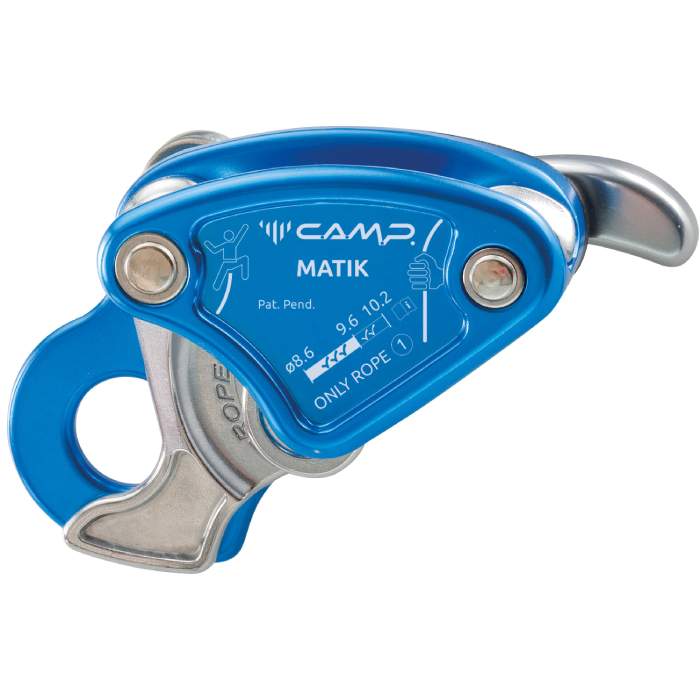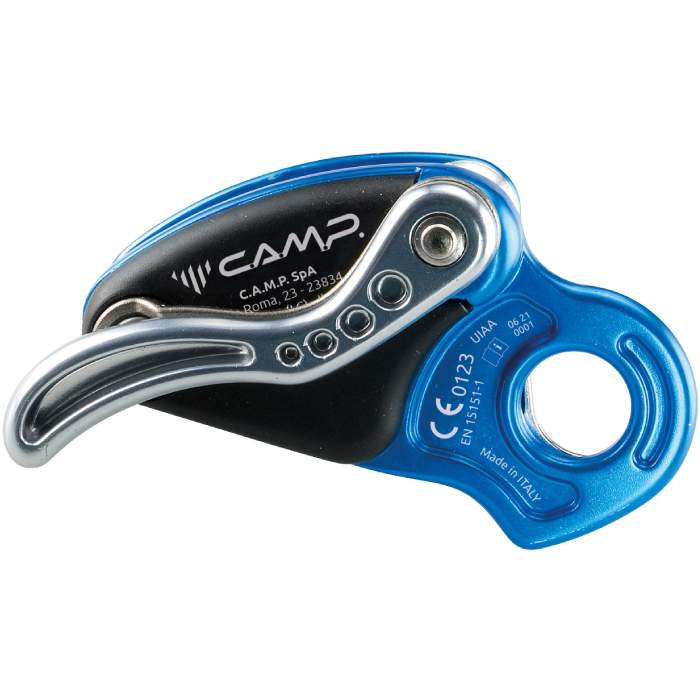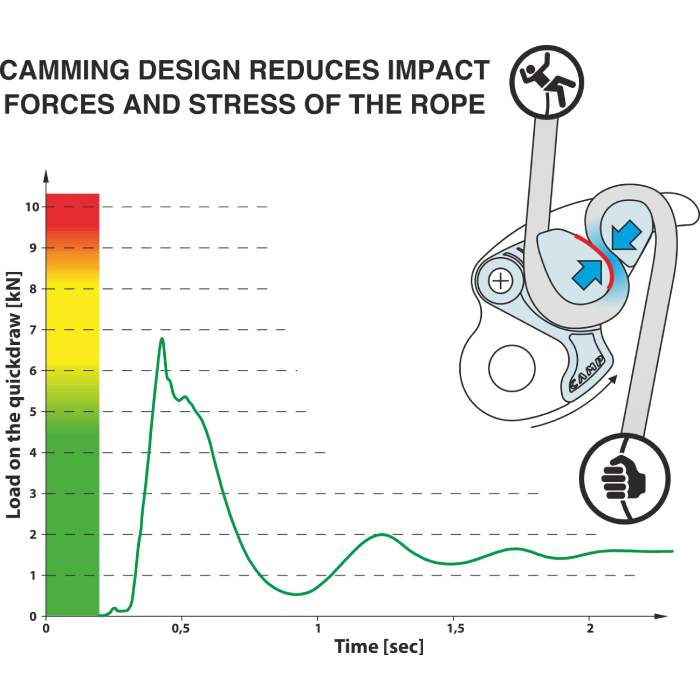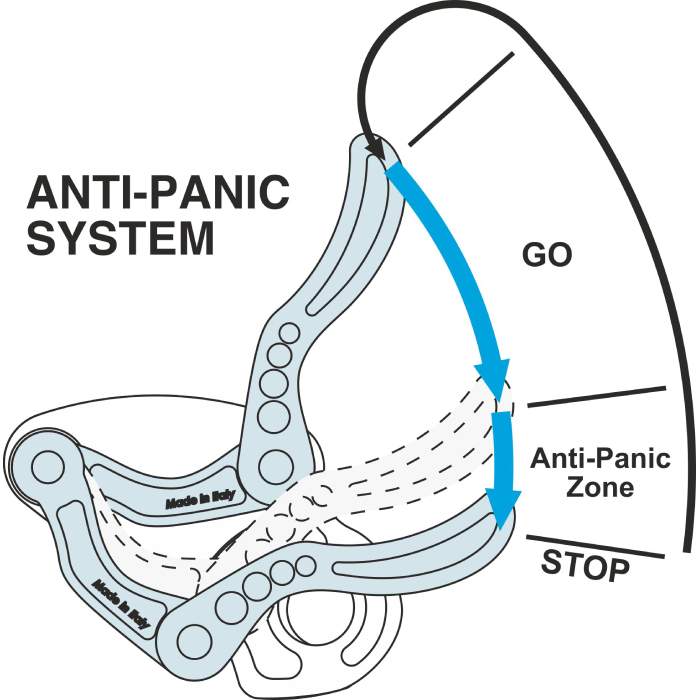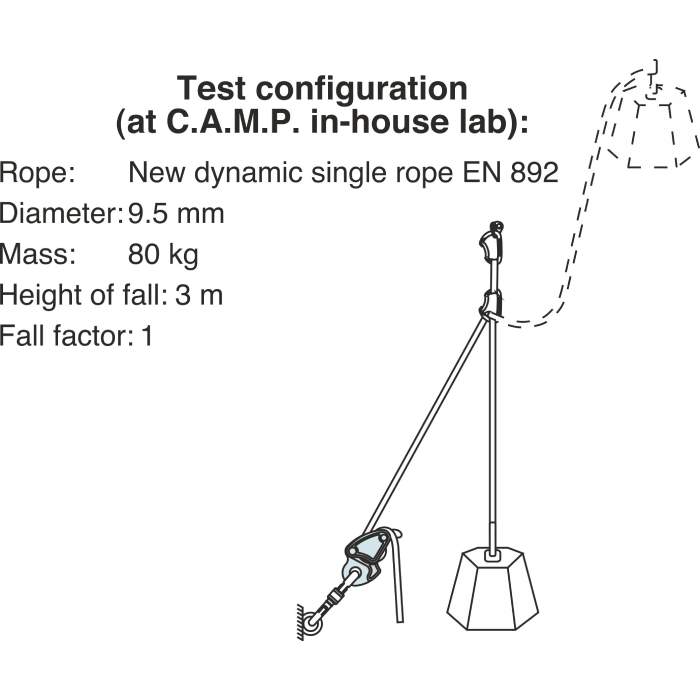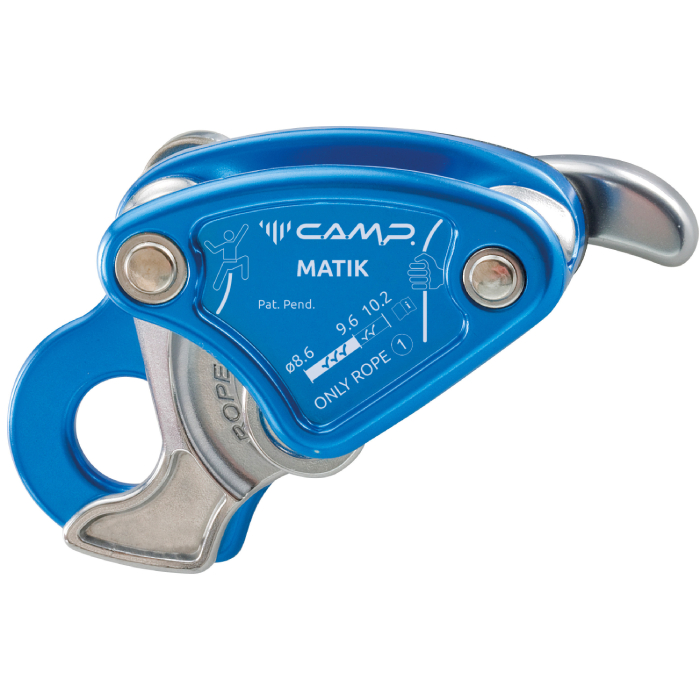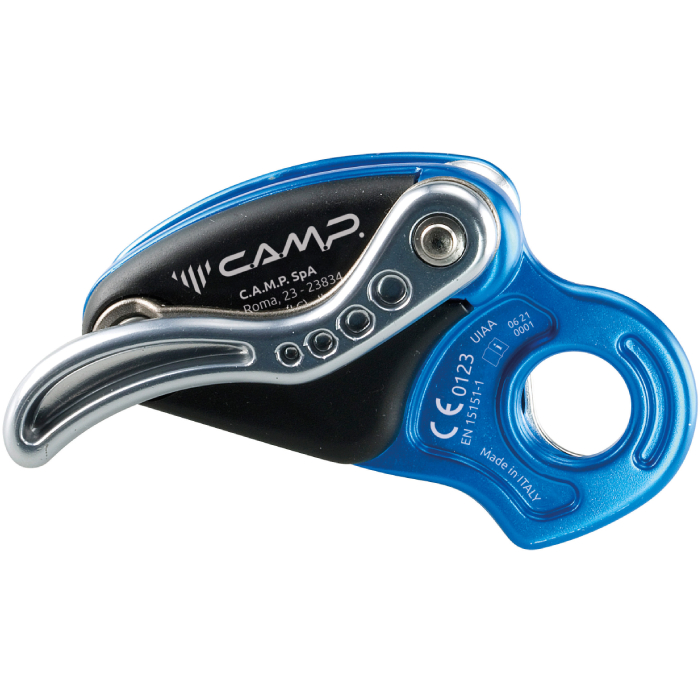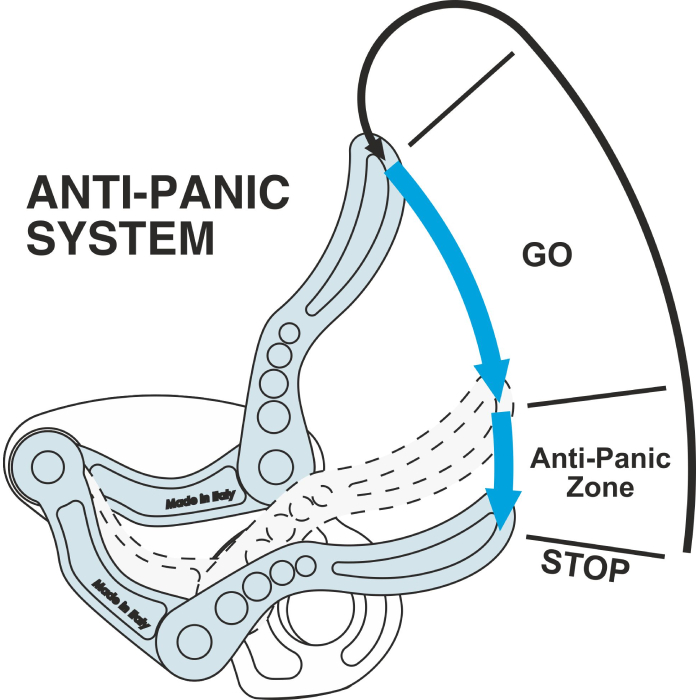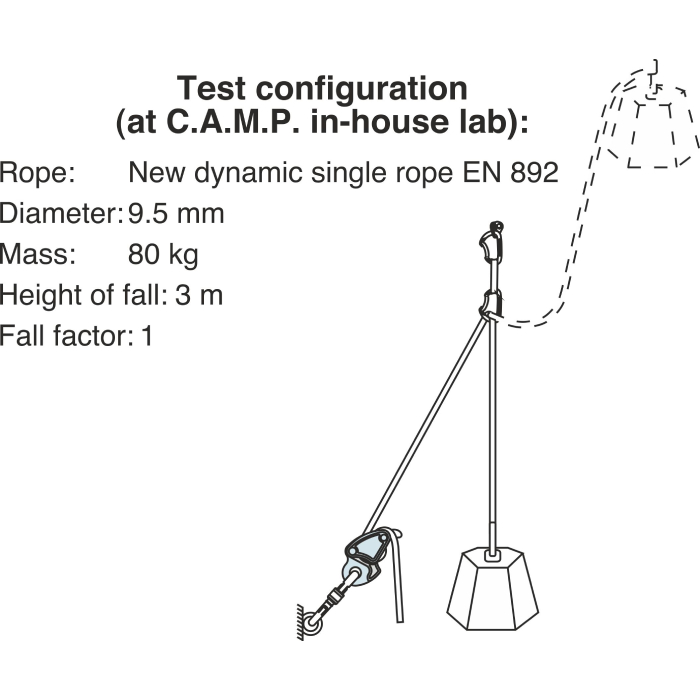Matik
Description
A revolutionary belay-descender device with assisted braking that delivers unparalleled safety and control.
Gradual camming action reduces the impact force of a fall and decreases wear and tear on the rope.
Proprietary Anti-Panic system automatically blocks the rope if the user loses control of the descent.
Double-hinged lever and straight rope path make the descent feel very fluid and controlled.
Intuitive design eliminates the possibility of clipping a carabiner to the device if it is not completely closed.
Wide attachment hole allows the carabiner to rotate through the hole.
High-end manufacturing with hot-forged aluminum main body and precision-cast stainless steel for the critical components that come in contact with the rope.
The assisted braking action of the Matik derives from an innovative camming design that makes the device safer and easier on the climber, the belayer, the anchor and the rope. Instead of using a blunt angle to pinch the rope abruptly when the cam is engaged, the Matik is built so the cam rotates in and comes in line alongside rope before it captures the rope completely. This alignment allows a much larger contact area between the cam and the rope (this makes the device more rope friendly than other auto-blocking devices), and the slight amount of slippage that occurs as the cam rotates into place reduce the impact force of a fall. This means less force on the bodies of the climber and belayer, and on the anchor! When lowering, the proprietary Anti-Panic system helps prevent one of the most common accidents occurring with the use of an auto-blocking device — losing control of the descent. The brake lever will automatically disengage causing the cam to automatically reengage if it is opened too quickly or if it is kept too far open where the speed of the descent can become unmanageable. This unique safety feature is particularly useful where there is little friction from rope drag between the belayer and the climber or during topdown descents where the Matik really delivers an unparalleled sense of safety and control. Users will also instantly notice that the Matik creates a very natural path for the rope that does not require looping or twisting of the rope during descent. Combined with the dynamic camming action that limits the impact of the fall, this more natural rope path helps to reduce wear and tear on the rope. Other distinguishing features of the Matik include a better method for inserting the rope that eliminates the possibility of clipping a carabiner to the device until it is completely closed.
NOTE: The assisted braking capability of the Matik does not relieve belayers of the need to adhere to the basic principles of belaying and rappelling. It is imperative to be attentive to the climber’s progress and always keep control of the brake line.
Retail price
When you click a link below and then checkout online, no matter what you buy (climbing gear or not), we get a small commission that helps us keep this site up-to-date. Thanks!
Device Type  Device TypeTubeThe most commonly used belay type also called an “ATC” or “tuber.” Other than a distinction between other belay device types, “Tube” is a rarely used term, most climbers just assume you're talking about this style when they refer to your "belay device." 
Figure 8Mostly used in rescue, canyoneering, tactical, work safety, or by old school climbers and rappellers. One reason they went out of popularity with recreational climbers is because they tend to create twists in the rope. 
Brake AssistThese devices assist in stopping the rope when a climber falls or hangs on the rope. 
Often referred to as “auto-blocking” but that’s not the official terminology because no belay device should be assumed to work automatically by itself, even if it feels like it does (or does most the time). PlateWhen simplicity is a must, or you started climbing before Tubers were the norm. Bonus: They tend to be very light weight. 
DescenderFor rappelling, not for belaying a lead climber or top-roping. 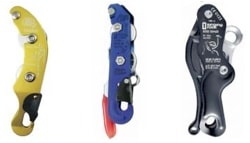 |
Brake Assist - Mechanical |
Weight (g)  Weight (g)In grams, the weight, as stated by the manufacturer/brand. |
276 g |
Belay Brake Assist  Belay Brake AssistThis is when the belay device significantly reduces the amount of holding power the belayer must exert to stop a fall and hold a climber. This is also called "assisted-braking" as the device must hold a significant amount of the climber’s weight; this term does not include friction-adding "teeth" found on some tube style belay devices. Confusingly referred to as “auto-blocking” or “auto-locking” these terms wrongly imply the device will always, automatically, stop a fall or hold a climber even if the belayer/rappeller is hands-free. These devices are not meant to be used without a hand on the braking side of the rope; the belayers/rapppeller brake hand should always be on the brake rope. Worth ConsideringMost of the mechanical brake assist devices only hold a single strand of rope and are not capable of double-strand rappelling (the most common method of rappel). |
Yes |
| Rope Options | 1 rope only |
Guide Mode  Guide ModeThis is when you belay directly off the anchor instead of your harness. Guide mode is helpful if you climb outdoors a lot because it reduces the holding power required from the belayer. When your partner falls or rests, the weight of the climber is held mostly by the anchor and the belay device. Tubers and PlatesWhen belaying in "guide mode," the tubers and plates turn auto-blocking. During a fall, the climbing rope pinches the slack rope, completely stopping the movement of either rope. A common guide mode setup shown below. 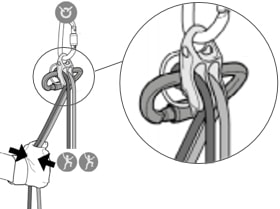
Mechanical Brake Assist DevicesThere is no difference in the functionality of the device. A brake-hand should always be on the rope to ensure the climber is caught in the case of a fall. A common guide mode setup shown below. 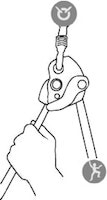
Where guide mode is used
Learn Morehttp://www.climbing.com/skill/essential-skills-auto-blocking-belay-devices/ |
1 follower only |
Teeth  TeethTeeth are only seen on tube devices. They add friction that helps grip the rope for more belaying control. This is helpful for belaying heavier climbers. Teeth are becoming standard on new tube devices. 
Worth ConsideringTeeth do wear out. You can limit wear by rappelling on the side without teeth (if you don’t need the extra friction). Once they’re worn, you’ll still have a usable belay device, just less friction. |
No |
Rope Range (mm)  Rope Range (mm)The range of rope diameters, in millimeters, that the manufacturer/brand specifies can safely be used. This is the best case scenario and does not necessarily take into consideration that certified ropes have a tolerance of +/- .3 mm. Recently, manufacturers have started to add an "optimized" rope range -- this is the range that will result in the nicest handling of the belay device. | 8.6 mm - 10.2 mm , optimized for 9.6 mm - 10.2 mm |
Certification  CertificationsThe main climbing gear certifications are CE and UIAA--and normally the UIAA creates the rules that the CE body also supports. When possible, we try to list all the certifications the product carries. To sell a climbing product in Europe, the device must be CE certified. There are no official requirements to sell climbing gear in the US. The UIAA certification is a voluntary process. Learn MoreRock and Ice Certifications Guide |
CE, UIAA |
so close to being good.
by anonymous on 02/20/2018If you are after a well made, high spec assisted breaking device then look no further. It’s built to last and has a whole range of useful features that no other device has on offer; however, if you are after such a top of the range device you will ideally need a thinner, performance rope to go alongside it as you may have trouble paying out with your older/thicker workhorse.
The Matik has a big focus on usability and an extremely low impact force; major pluses when it comes to increasing the durability of everything in your system, from your rope to your pro to your partner.
CAMP has spent a lot of time crafting the Matik belay device, adding features to improve safety and increase equipment longevity. Of course, climbers must decide for themselves if these impressive features justify the price, but I’ll tell you this, if my belayer was buying a new mechanical brake-assist device, I would definitely steer him/her towards the Matik.
The Camp Matik impressed us with its sturdy construction and combination of safety features. Its anti-panic lowering lever and gradual camming action are sure to prevent some real-world injuries. Though, these benefits come with drawbacks. It's heavy, 9.7 oz, and not quite as smooth as the GriGri 2. In addition, we suspect the $200 price tag will be a deal breaker for many shoppers. Until that price comes down, the Matik is best suited for users whose sole concern is safety.
See all the features and demonstrations of the CAMP Matik.
This video goes into the nitty gritty; it has photos, demonstrations and explanations.
This video goes over the new Belay Devices and Ascenders that were slated to come out in 2015. Including the CAMP Matik, DMM Pivot, Mantis and Grip, along with the Edelrid Jul2. It also covers the new Black Diamond Index ascender and the upgrades to the Petzl Ascension.

